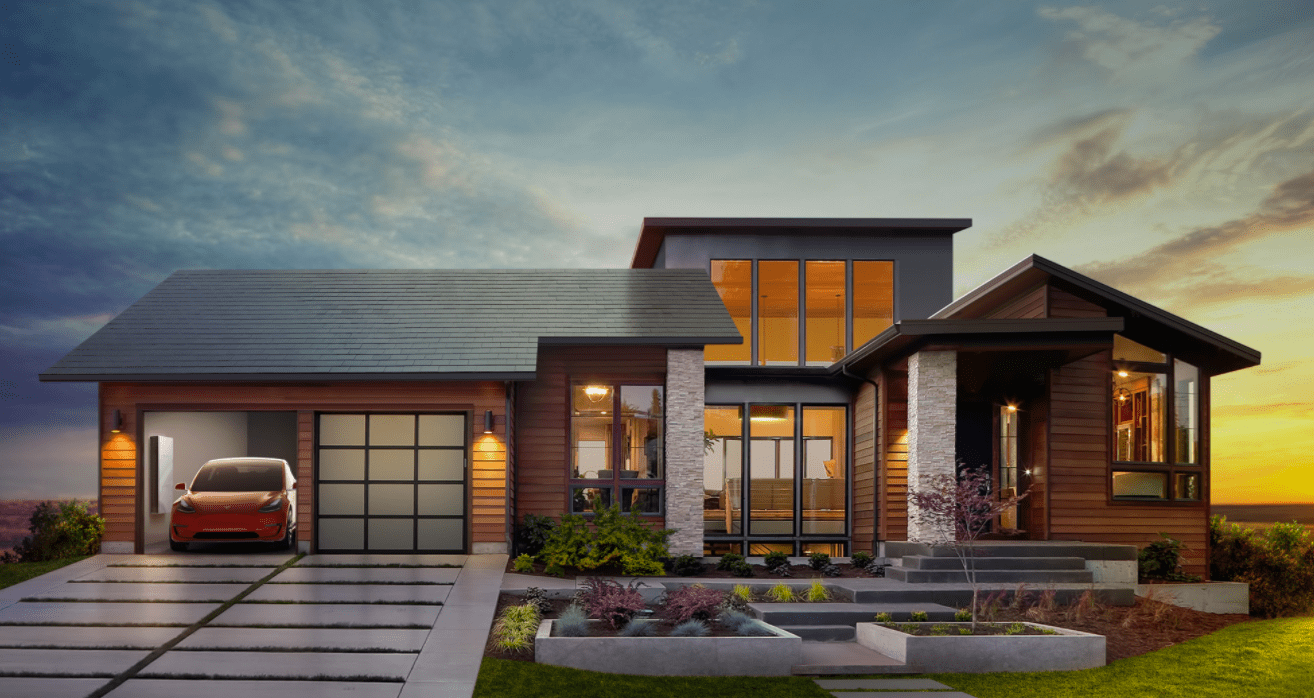Tesla and SolarCity’s big solar roof reveal last week left many, including us, scratching our heads.
Yes, the solar shingles that leader Elon Musk showed off on the roofs of the Universal Studios film set are the best looking home solar panels we’ve ever seen. But the companies provided almost no details about how and when they plan to make them and how much they’ll cost.
But following Tesla and SolarCity’s conference call with reporters on Tuesday, and an interview Fortune did with one of Tesla’s partner’s 3M, here’s a bit more information.
On the film for the solar roof tile:
A solar roofing tile is made of a glass layer, some films and then solar cells. Sun shines on the tiles, through the glass and the films, and through to the underlying solar cell, which converts the light into electricity.
3M (MMM) corporate scientist Andrew Ouderkirk told Fortune that 3M developed a new solar film specifically for Tesla to enable Tesla’s (TSLA) solar roofing tile to both efficiently convert sunlight into electricity and also to appear to be a different color when viewed from the street.
For more on the pros and cons of the Tesla/SolarCity deal watch our video.
When the solar roof tile is viewed from the ground, tiny louvers in the film can make the tile appear to be the color of slate or an earth tone. “Its like a micro venetian blind,” said Ouderkirk, explaining that it works in a similar manner to a privacy film that goes on a computer screen that blocks anyone from the side from trying to look at the screen.
Ouderkirk said that Tesla came to 3M with the concept and that 3M was able to collaborate with the company and turn around the film “fairly quickly.”
3M makes a variety of solar films that do things like boost efficiency, protect solar cells, or enable panels to be flexible. 3M wouldn’t comment on the business relationship with Tesla or how long the companies worked on the solar film.
On Tesla and SolarCity’s (SCTY) call on Tuesday, Musk briefly discussed some of these materials and processes in more depth. He said that the tiles would use “hydrographic coloring,” (basically using a water-based printing process) and that the micro-louvers on the films would make the various roof tile colors possible.
Get Data Sheet, Fortune’s technology newsletter.
He described the micro-louvers as basically “very durable plastic.” He also explained how the tiles would snap into a basic structure to integrate into a roof.
On the glass for the solar roof:
Musk said on the call on Tuesday that Tesla has created an automotive glass technology group. The result of the company’s first glass innovations are being used on Tesla’s upcoming electric car the Model 3, which is supposed to come out in late 2017. Musk didn’t clarify how the glass tech would be used for the Model 3, but we’d assume for the swooping glass roof.
Musk said that the solar roof tile could potentially use “a lot of techniques from the automotive glass business.” He also noted that in high volume glass is “very cheap and very resilient.”
On production of the solar cell:
On the Tuesday call, Musk also gave more clarity about Tesla’s partnership with Japanese giant Panasonic to work together on solar technology. Last month Musk announced that contingent on the planned Tesla and SolarCity merger, the combined companies intend to work with Panasonic at SolarCity’s solar factory that is under construction in Buffalo, N.Y..
At the Gigafactory, outside of Reno, Nev., Panasonic makes battery cells for cars and buildings and Tesla “does everything past the cell level,” said Musk. “I expect something similar in Buffalo. He added that discussions with Panasonic about the latest solar deal “have gone very well.”
Tesla and SolarCity also plan to work with Panasonic to integrate SolarCity’s Silevo solar cell technology, which SolarCity got through an acquisition several years ago. The companies said they plan to create a version of the solar cell using the best techniques from each company.
For example, SolarCity CTO Peter Rive said that Silevo had perfected what’s called a “heterojunction cell” (basically multiple layers of semiconductors) using a 6-inch wafer, while Panasonic hasn’t yet transitioned to using a 6-inch wafer for solar cells. “We’ll take Silevo’s learnings on 6-inch and apply them to the learnings that Panasonic has achieved over the years for scaling heterojunction cells to gigawatts and beyond,” said Rive.
On the price of the solar roofs:
SolarCity’s Rive also said that the company thinks it can get to a solar cell cost of 40 cents per watt over time at large scale, which is competitive with current commodity solar panels. But Rive said a Tesla/SolarCity solar panel would have efficiencies in the 22% to 24% range, an improvement over commodity solar panels that more commonly convert around 10% to 15% of light into electricity.
“We’ll have the best [solar] cell at the lowest price,” said Musk. Hydrographic coloring is an inexpensive process, the micro-louver film made in volume is very low cost, and large volumes of glass are cheap, he explained.
“I don’t know why nobody’s done this before. It blows my mind,” said Musk.
